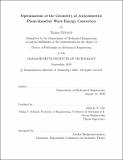Optimization of the geometry of axisymmetric point-absorber wave energy converters
Author(s)
Edwards, Emma(Emma Chute)
Download1227037428-MIT.pdf (5.076Mb)
Other Contributors
Massachusetts Institute of Technology. Department of Mechanical Engineering.
Advisor
Dick K. P. Yue.
Terms of use
Metadata
Show full item recordAbstract
Wave energy represents an abundant source of renewable energy, but as yet the potential is not fully utilized. Aiming to exploit this vast potential, many theoretical, experimental and pilot-scale studies have been conducted on wave energy converters (WECs), however as yet there has been no convergence on the optimal shape of a WEC. Furthermore, there is no agreed-upon definition of what it means for a WEC to be 'optimal' and no established framework to find optimal shapes. This thesis establishes a novel, scientifically rigorous framework to find practically realistic optimal shapes of WECs. Through a general, efficient and efficacious procedure, we systematically investigate groups of shapes to reveal powerful new results for the optimal shapes of axisymmetric WECs. Finally, we analyze these results to develop insights and gain physical intuition about the best WEC shapes. Although the hydrodynamics of WECs under operating conditions can generally be considered linear, the dependence of the hydrodynamics and power extraction of the geometry can be highly nonlinear. In this thesis, we assume linear hydrodynamics but allow the geometry to be very general and consider a wide range of possible geometries. We optimize a single-body deep-water 3D axisymmetric point absorber WEC, with linear power take-off mechanisms, assuming a monochromatic unidirectional incoming wave with given wavenumber k. We consider two separate problems: a WEC moving and extracting energy in the heave mode only, as well as the complete 3D problem of an axisymmetric WEC moving and extracting energy in heave, surge and pitch. This thesis develops a robust computational approach for finding the optimal WEC shape underpinned by a strong theoretical grounding. We describe general geometries using piecewise parametric polynomial basis functions and develop a multi-objective optimization to minimize WEC surface area and volume, while ensuring constant, maximum power for all shapes. We show that constraints are necessary to ensure feasible body motion, weight distribution and stability. We present a novel theorem to find roots of the heave resonance equation, which adds to our understanding of the problem and significantly speeds up the optimization process by effectively decreasing the degree of freedom of the optimization. Our systematic investigation encompasses a broad range of shapes, starting with truncated cylinders and then generalizing to significantly more complex shapes. We show that shapes that protrude outwards below the waterline generally perform better, due to their high heave damping coefficient, which enables smaller volumes while still adhering to the motion constraint. Furthermore, in general the maximum radius occurs closer to the waterline than the maximum draft. Compared to the heave-only problem, the optimal shapes from the heave-surge-pitch problem are generally wider and less protruding outwards, resulting in a larger volume and surface area. The trends that we observe in the optimal shapes are consistent across all the groups of shapes, implying these may be features of a general optimum. Optimizing the geometry can significantly decrease the material used to produce the same, maximum power: for example, the optimal shapes have up to 72 % less surface are and 93 % less volume than the optimized cylinders. The methodology developed, along with the results found, in this thesis will help to inform future WEC development. Through the discovery of WEC shapes which extract maximum power and require minimum material use, whilst ensuring the WEC shapes are practically feasible, this thesis is a step forward in our understanding of WECs and ultimately contributes towards wave energy becoming a viable source of renewable energy in future.
Description
Thesis: Ph. D., Massachusetts Institute of Technology, Department of Mechanical Engineering, 2020 Cataloged from student-submitted PDF of thesis. Includes bibliographical references (pages 281-285).
Date issued
2020Department
Massachusetts Institute of Technology. Department of Mechanical EngineeringPublisher
Massachusetts Institute of Technology
Keywords
Mechanical Engineering.